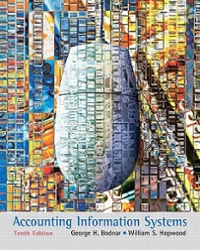Question
Ten MCQ and ten T & F questions MCQ: (1) Which of the following statements does not describe an analytical review procedure? A. The auditor
Ten MCQ and ten T & F questions
MCQ:
(1) Which of the following statements doesnotdescribe an analytical review procedure?
A. The auditor considered the relationship between financial information and relevant non-financial information.
B. The auditor compared the client's gross profit ratio with the average gross profit ratio for the industry in which the client operates.
C. The auditor compared recorded amounts of major disbursements with appropriate invoices.
D.The auditor compared recorded expenses with budgeted amounts.
(2) Which of the following statements best describes the purpose of applying analytical procedures in an audit?
A. Test for inefficiencies in operations
B. Understand internal controls
C. Identify unexpected fluctuations and relationships
D. To assist the auditor in evaluating his/ her competency to perform the audit.
(3) Which of the following statements suggests that the client's inventory is obsolete?
A. A decrease in the ratio of gross profit to sales
B. A decrease in the number of days in inventory
C. An increase in the ratio of COGS to accounts payable
D. A decrease in the inventory turnover ratio.
(4) An auditor will apply the times interest earned ratio in order to evaluate:
A. The ability of the client to meet its commitments as they fall due.
B. The profitability of the client.
C. The adequacy of the client's allowance for doubtful debts
D. The stability of the client's revenue
(5) Which of the following statements isnottrue?
A. Disaggregated data relationships are more precise than data that is aggregated.
B. Data obtained from the client's trial balance for the present year is more reliable than data that was audited in the previous year because it is timelier.
C. Ratios based on figures that are subject to management discretion are less useful than those based on figures that are not subject to management discretion.
D. Relationships in a stable environment are more predictable than those in a dynamic environment.
(6) Which of the following doesnotconstitute sampling?
A. Select all accounts receivable balances with a value greater than $200,000 and confirm them with the appropriate debtor.
B. Select 30 Sales Orders and inspect to ascertain if they have been properly authorised.
C. Select every 100th payment recorded in the Cash Payments Journal during the period and vouch them to the corresponding source documents.
D. Randomly select 15 items from the asset register and inspect the physical items to test the existence assertion.
(7) An advantage of using a statistical sampling technique is that:
A. The tolerable error is determined correctly.
B. It is superior to judgement-based techniques.
C. Most auditors in Australia use this approach.
D. Sampling risk can be measured.
(8) Which of the following is an element of sampling risk?
A. Failing to perform an audit procedure that is specified in the audit program.
B. Choosing a sample size that is too small to achieve the objective of the test.
C. Failing to detect a deviation on a document that has been inspected by the auditor.
D. Choosing an audit procedure that is inconsistent with the audit objective.
(9) Which of the following methods of sample selection isleastdesirable?
A. Random selection
B. Haphazard selection
C. Systematic selection
D. Block selection
(10) If all other factors remained constant, the impact on sample size of a change in the tolerable
error from 8% to 6% would be:
A. Increase the sample size
B. No effect on sample size
C. Decrease the sample size
D. None of the above because we need to know the population size in order to determine the tolerable error.
T & F question:
- You are auditing Red Pty Ltd (Red). You decide that a sample size of 20 is appropriate for testing the authorisation of Purchase Orders. Your assistant selects the sample and finds that on one Purchase Order, the ink has faded and so she cannot determine if it was signed or not. You ask her what she proposes to do. She replies, "there is nothing to worry about, I selected 20 items, as required under the audit program. This is just an example of sampling risk, which is always present.
- Profiling can be used to discover patterns of behaviour by examining data that is stored in a database and is readily searchable.
- Benford's law states that, in many naturally occurring collections of numbers, the significant leading digit is likely to be large.
- By applying the clustering technique in data analysis, the auditor seeks to identify groups of similar data elements and understand the relationships between the data elements within the groups.
- When applying regression analysis an auditor would be most confident of a prediction she made if the R-squared value was low
- If the auditor assesses Inherent Risk to be high, he will require a larger sample size.
- When using stratification an auditor can use a smaller sample size.
- When applying ratio analysis, a higher number is always preferable to a lower number.
- When applying ratio analysis, an auditor will assume that greater predictability is achieved when there is a direct relationship (as opposed to an indirect relationship) between the data elements.
- Calculating the standard deviation of a sample is an example of an Analytical Procedure
Step by Step Solution
There are 3 Steps involved in it
Step: 1

Get Instant Access to Expert-Tailored Solutions
See step-by-step solutions with expert insights and AI powered tools for academic success
Step: 2

Step: 3

Ace Your Homework with AI
Get the answers you need in no time with our AI-driven, step-by-step assistance
Get Started


